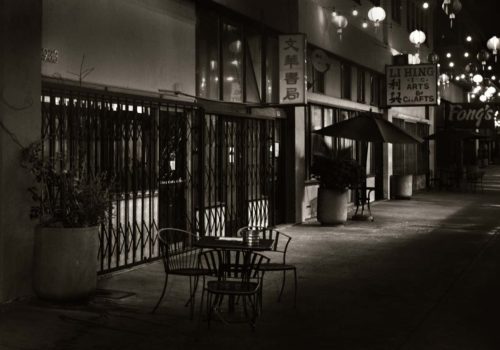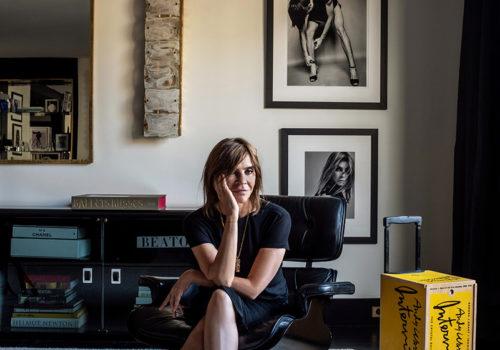I have a background in low budget horror movies and I love the genre, I love the dark stuff, I love black and white films, dark prints,…my sensibilities seem to go there. At the same time I like the aesthetically dark as well as physically dark.
On the one hand there is the gallery, all beautiful and gleaming. Prints hang on the walls under perfect light and people move from image to image like Stations of the Cross. On the other hand there is the darkroom, the place where fine art analog prints are made. Usually black, confined and smelling of chemicals, darkrooms are places most collectors will never see. drkrm bridges these worlds in a most interesting way. Founded by master printer John Matkowsky, drkrm is both a fine art printer and a gallery, working with photographers to make their images beautiful and tangible and then showing them in their new space on Chung King Rd in Chinatown. I spoke with John to discover how drkrm came to be and the kind of work he intends to show.
Andy Romanoff: Tell me how you came to be both a fine art printer and a gallerist.
John Matkowsky: In 82 I came out to LA to work on movies and I worked for free but free doesn’t pay the rent so I got a job at photo lab. It was a commercial lab, called Modern, and they were printing for companies like McCann Ericson, all the big advertising agencies in town. Then someone turned me on to another job, working more as a fine art printer. It was a place called Silverlab, owned by Tom Consilvio. He was printing for Gary Winogrand, Bill Claxton; a whole lot of people you’ve heard of. I had been there for about three years one day he took me to lunch, I’ll never forget this and he said ’you’re the best printer I’ve ever met, you have a problem with judgment, you don’t know when to stop, but I can teach you that, you’re on the right path.’ For the next year, he would oversee me. I would show him the print and he would tell me what to change but not who I was printing for. Only later I’d find out it was Gary Winogrand or somebody like that. I learned a lot from him. At the time we were known for our black and white prints, doing work for a lot of great clients, we were doing Platinum prints, things like that. Unfortunately, not long after, Tom died but the business was bought so I stayed there another fifteen years until they went out of business in 2005. When they closed they offered me all the equipment for $2500 dollars so I raised the money and started looking for a space. I figured I would open a little lab that specialized in fine art prints for really cool people. It would be just me and you, no counter people, just one on one and you could tell me what you want and I’ll do a test for you and we could discuss it and then I’d make the print. I had this great space on San Fernando Rd, a really big space with all white walls and someone suggested I should do a group show of all my clients work. We did it and some of the pieces sold and that was cool because the show was more about showing, not about selling but after it was over someone said ’What are you doing next?’…and I hadn’t even thought about that. So we started to show, to do something every month and it kind of took off from there.
AR: The gallery has an unusual bias. Can you talk about how you choose what you show?
JM: I have a background in low budget horror movies and I love the genre, I love the dark stuff, I love black and white films, dark prints,…my sensibilities seem to go there. At the same time I like the aesthetically dark as well as physically dark. I like things you don’t get to see every day, prostitution, gay stuff, a lot of things you will never see in another gallery, that’s what I go for.
AR: But at the same time you’ve shown Ansel Adams…
JM: Ok, let me clarify that and you can quote me on this, I’m not a big fan of Ansel Adams. I’m not a big fan of snow covered mountains and pretty forests, I mean I love those things in real life but when you’ve seen one Ansel Adams you’ve seen them all. The Ansel Adams I showed is down and dirty, it’s LA noir, its overcast skies and slick streets from the rain. It’s not ’Ansel Adams’ and that’s what I really liked about it. If someone came up to me and said ’I have Half Dome’, that’s not for me, but if you show me Sunset Boulevard that works for me, that’s the Ansel Adams I like. I’m a huge fan of street photography and you can’t get any bigger than Ansel Adams.
AR: How does the LA art establishment relate to what you’re showing?
JM: You mean other than ignoring it completely? Well there are a couple of factors in that. For one I’m very young in the gallery business, I’ve been around less than ten years, I’m nobody. All the other galleries that get attention are better established, they have been around for a long time. The LA Times reviews a half a dozen shows and they are all museum shows or better established galleries so it’s really hard to get in there. At this stage, any attention, any publicity you get you have to create yourself.
AR: Did you print the Ansel Adams negatives?
JM: Yes I did, in September of last year I was approached by the Los Angeles Public Library. They were looking for someone to make prints from their collection. They came by and checked me out and I guess I passed so now they send me two or three negatives a week from their archives, 8’ x 10’ or 4’ x 5’ and I make fiber prints for them. Once I met them I was invited by Christina, who’s the head of the department to take a tour of the collection. It was rooms and rooms of files and negatives, amazing stuff, and near the end she came to some files and said ’This is our Ansel Adams collection, you should check it out online.’ I did and when I went through them with my partner I realized it was the basis for a show and when I went back and proposed it she was very receptive. Christina took our proposal to the board and after some delays it was accepted. The only problem was that in order to fit the show into our schedule I now had only about five weeks to print all the 16by20s and 20by24s for exhibition.
AR: How did it feel to be printing all those Ansel Adams negatives for display?
JM: I just did it the best I could. If there was detail in the negative I just made sure it was in the print. For instance, if there was detail in the sky, if there were clouds, I made sure we saw the clouds. I just did the very best I could but it was fast and furious.
AR: Talk about Chung King Rd, tell me what you see going on here.
JM: Well Chung King Rd started as a gallery site around 2003 and the first gallery that moved in was located right in this space. Then other galleries moved in and Chung King became a recognized gallery site. Now a few years later, some of the more successful galleries have moved to places like Culver City, to Berlin, and eventually that’s what I hope will happen with us.
AR: what kind of work are you looking for as a gallery owner?
JM: I’m looking for dark stuff; I’m looking for war stuff, I’m looking for any kind of photojournalist stuff about the seventies, eighties, especially the eighties in LA. You figure there would be a lot of photography of the eighties in LA but there isn’t. That’s what I like, that’s what I’ll show. And it doesn’t matter how old you are. The older you are, the more stuff you have to show.
AR: You spend your days making beautiful prints for others. Do you shoot any pictures yourself?
JM: I do…with my IPhone…
AR: I’ll pretend I didn’t hear that…
















